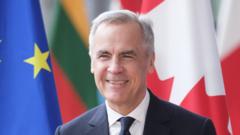In recent discussions around Canada’s opioid crisis, the emphasis has transitioned from the health impacts of opioid use to measures addressing the trafficking of fentanyl across the border. This change has been largely driven by U.S. political statements, prompting Canada to enhance its border security strategies.
Canada’s Opioid Crisis: Evolving Perspectives Amid Border Control Measures

Canada’s Opioid Crisis: Evolving Perspectives Amid Border Control Measures
The focus on Canada's opioid crisis has shifted from health policies to border control, influenced by external political narratives, particularly from the U.S.
The dialogue surrounding the opioid crisis in Canada has taken a notable turn recently, moving away from discussions centered on health policies aimed at mitigating the alarming death toll due to opioids. Just a year ago, the emphasis was overwhelmingly on health strategies, especially in light of recent policy shifts in British Columbia, including the reversal of drug decriminalization efforts. However, renewed focus on the pharmaceuticals' trafficking and enforcement measures has taken center stage, much to the influence of external political narratives, particularly from the United States.
Former President Trump’s assertions that Canadian authorities are complicit in the trafficking of "massive" quantities of fentanyl into the U.S. have prompted Canada to reconsider its stance on border security. Despite U.S. Customs and Border Protection data indicating that less than 1 percent of fentanyl seizures originated from Canada, these claims have led to significant shifts in public and governmental focus. Consequently, the Canadian government has introduced measures to improve border oversight by appointing what is colloquially referred to as a “fentanyl czar” and channeling substantial resources into new technological solutions, such as drones and helicopters for border surveillance.
Previously, when I interned at the Canada Border Services Agency (CBSA), there was a strong focus on redefining border security from a physical barrier to a complex network aiming to intercept threats early in the process. This innovative approach has now gained renewed urgency as the country grapples with the illicit distribution networks that thrive on the opioid crisis. For instance, it’s worth noting that a relatively small quantity of fentanyl—approximately 500 grams—can yield profits surpassing 30,000 Canadian dollars, underscoring the lucrative nature of this illicit trade.
As Canada navigates its response to the ongoing crisis, these emerging narratives concerning trafficking and legislative changes continue to shape public discourse and policy priorities. This pivot in focus raises questions about the long-term societal implications and marks a significant change in how Canada approaches one of its most pressing public health challenges.
Former President Trump’s assertions that Canadian authorities are complicit in the trafficking of "massive" quantities of fentanyl into the U.S. have prompted Canada to reconsider its stance on border security. Despite U.S. Customs and Border Protection data indicating that less than 1 percent of fentanyl seizures originated from Canada, these claims have led to significant shifts in public and governmental focus. Consequently, the Canadian government has introduced measures to improve border oversight by appointing what is colloquially referred to as a “fentanyl czar” and channeling substantial resources into new technological solutions, such as drones and helicopters for border surveillance.
Previously, when I interned at the Canada Border Services Agency (CBSA), there was a strong focus on redefining border security from a physical barrier to a complex network aiming to intercept threats early in the process. This innovative approach has now gained renewed urgency as the country grapples with the illicit distribution networks that thrive on the opioid crisis. For instance, it’s worth noting that a relatively small quantity of fentanyl—approximately 500 grams—can yield profits surpassing 30,000 Canadian dollars, underscoring the lucrative nature of this illicit trade.
As Canada navigates its response to the ongoing crisis, these emerging narratives concerning trafficking and legislative changes continue to shape public discourse and policy priorities. This pivot in focus raises questions about the long-term societal implications and marks a significant change in how Canada approaches one of its most pressing public health challenges.




















